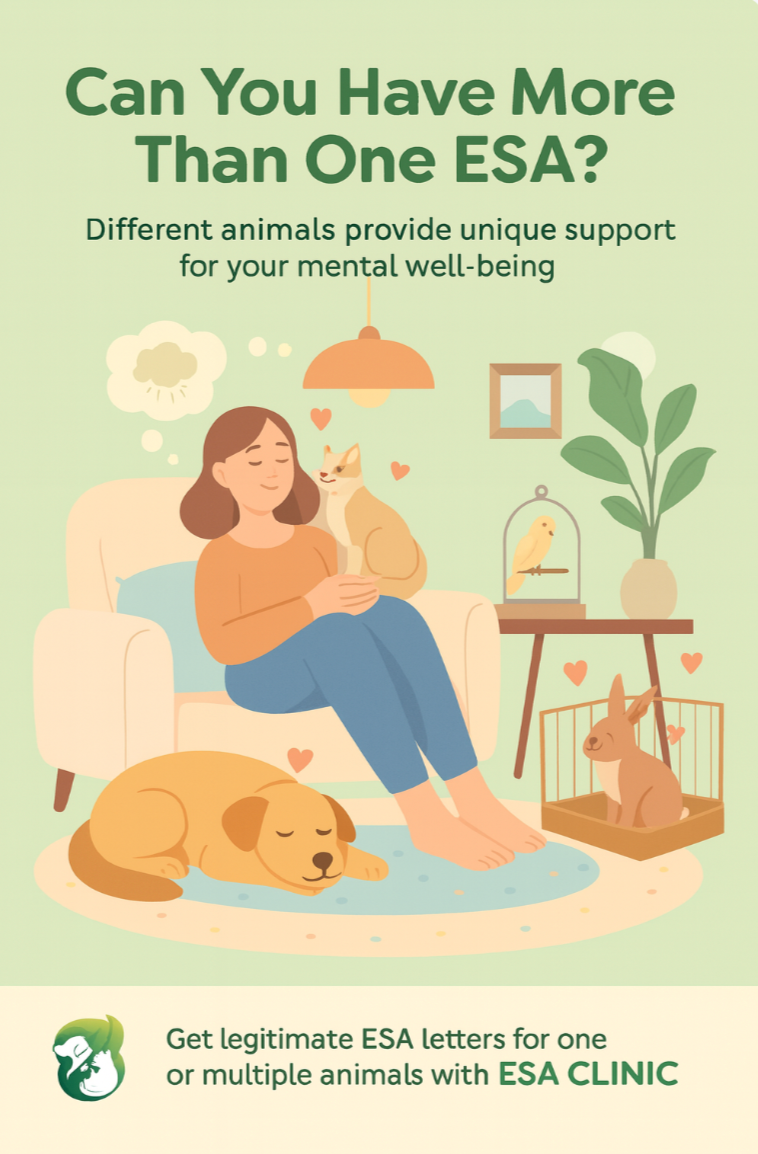For many people, most pets are not just companions – due to the emotional love for them, they serve as the emotional anchor that keeps us grounded (and sane) during tough times. Many Emotional Support Animals, or ESAs, help people manage their mental health by offering support as people learn to live with anxiety, depression, PTSD, or panic disorder, to name a few. One question that we often get asked is – Can I have more than one emotional support animal?
The short answer is, yes – if your mental health provider identifies that you need more than one support animal, you can have multiple ESAs! But this is not as simple as just bringing another furry friend into your life; there are guidelines, responsibilities, and legal issues that you must recognize before you can comfortably live with more than one ESA.
This article seeks to engage you in the details of having more than one support animal, the laws that cover it, the benefits and challenges, as well as how to ensure you and your animals can comfortably live together.
Understanding the Role of Emotional Support Animals
Emotional support animals (ESAs) are unlikely to be service animals trained to perform care tasks for an individual with a disability. ESAs provide emotional comfort through companionship, which can reduce stress, stabilize moods, and alleviate symptoms of mental health challenges.
The importance of an ESA is not attached to a particular species either. Dogs and cats are the most likely ESAs; however, rabbits, birds, guinea pigs, and even mini horses can be considered ESAs. The important thing is that an LMHP (Licensed Mental Health Professional) has recommended the animal to provide companionship for the individual in need.
Can You Really Have More Than One ESA?

Yes, you can. However, it must be clinically justified.
For instance:
- A person with PTSD may find the dog grounding during a flashback, but the cat is soothing when they are experiencing panic attacks.
- Someone with severe depression may find that their rabbits give them the motivation to care for another living creature, and their dog motivates them to get exercise.
The main takeaway is that each animal must have a specific therapeutic purpose. Your therapist or mental health provider must assess your needs and clarify that having multiple ESAs is helpful for your specific condition.
The Legal Framework for Multiple Emotional Support Animals
When it comes to ESAs, two major legal protections apply in the U.S.:
Fair Housing Act (FHA)
The FHA protects how housing providers (landlords, property managers, and housing associations) operate with reasonable accommodations for persons with ESAs, even under “no pets” situations.
If you have more than one ESA, a landlord cannot blanket deny the requested accommodation due to the fact that there are multiple animals. However, if you have more than one ESA, the landlord can request documentation from your LMHP, specifically stating the need for more than one ESA.
That said, ” reasonable accommodation” comes into play as well. For example, requesting three large dogs in a small studio could be deemed unreasonable based on the amount of space.
Airline Travel (Post-2021 DOT Rule)
Previously, ESAs had a special protection for air travel (even if not fully recognized) under the Air Carrier Access Act (ACAA). However, since 2021, airlines are no longer required to recognize ESAs. Most airlines now view ESAs as regular pets, which means you will be subject to their pet travel policies and associated fees. Taking multiple ESAs could present complications for air travel.
Benefits of Having More Than One ESA
Complementary support
Different types of animals offer different types of emotional support. Dogs help with reducing feelings of loneliness and encouraging physical activities, whereas cats provide comfort and calm in high-stress moments.
Stronger sense of companionship
Having more than one ESA can feel like family. Many people feel that the care associated with multiple animals adds routine and responsibility, motivating positive mental health strategies.
Support for specific scenarios
In some scenarios, having one ESA may be a more helpful option than another. For example, a dog may assist with panic attacks in public, while a bird’s song may provide comfort on lonely, quiet nights.
Minimize dependence on a single animal.
Having multiple ESAs can help to distribute emotional burden with more than one companion. This can be helpful to prevent over-dependence on one animal to fulfil all emotional needs.
Challenges of Having More Than One ESA
Landlord and Housing Issues
Although the FHA extends protection to owners of ESAs, a landlord may still have concerns about possible property damage, noise, or possibly even limited space. It may take some compelling documentation to negotiate them accepting two ESAs.
Financial Impact
Although expenses can vary, having two pets will increase your expenses, including vet bills, food, grooming, and other costs. You need to be fully informed and prepared for this financial commitment.
Animal Compatibility
Not all animals are compatible with one another. The introduction of multiple ESAs will require planning, socializing, and patience for them to all get along within the home.
Travel Restrictions
As airlines begin restricting animals to horses and service dogs, you may find that traveling with multiple animals becomes expensive or even impossible/overwhelming.
Social Stigma
It is common to feel that some people will view two ESAs as “too much” or assume that the owners must be abusing the system. Be prepared to justify your legitimate situation when possible.
How to Get Approved for More Than One ESA
The steps are simple, but accurate documentation is critical:
Consult with Your Mental Health Provider
Engage your LMHP in conversation about your emotional needs and why you feel having multiple animals meets those needs. Be as honest and descriptive as you can be about your experience.
Receive your Legitimate ESA Letter
If your therapist qualifies that you need multiple ESAs, they will give you an ESA letter that defines the medical necessity for having more than one animal. The letter will clearly explain why each ESA is needed.
Provide the ESA Letter to Your Landlord
Include the letter in your reasonable accommodation request. Be open to discussions about space, size, and reasonable expectations.
Remain Responsible as an Owner of an Animal
You have a legal responsibility to ensure that your animals are not a threat to the other tenants ordos not interfere with another tenant’s use and enjoyment of their unit. You should be properly training your animals and caring for them.
Practical Tips for Managing Multiple ESAs
- Keep them in separate spaces so they will not clash.
- Introduce them in gradual steps until they are bonding positively together.
- Establish a routine for feeding, exercise, and recreational play.
- Make sure you budget to afford all of the animal care for each veterinarian and for each animal’s supplies.
- Keep them trained so they will behave themselves when they are in the same shared spaces.
When Having More Than One ESA May Not Be Ideal
Having multiple ESAs might work out for you, but it is not always the best option. There are things to seriously consider before you decide:
- You live in a very small space with limitations:
- You can’t afford the extra costs of multiple pets
- You have a busy lifestyle and don’t have time for animal care
- Your current ESA is not good at sharing attention or space
You also need to understand that the well-being of your animals is entirely as important as your own mental health.
The Emotional Side: Real-Life Scenarios
- Sarah, 28, with severe anxiety, found comfort in her cat’s constant presence at home but needed a dog to encourage her to step outside and face social situations. Both animals met different needs.
- John, a war veteran with PTSD, benefited from his service dog but also found comfort in having a parrot that distracted him with companionship and chatter during lonely evenings.
These examples show how more than one ESA can truly make a difference in someone’s emotional health.
Final Thoughts
Yes, you can have more than one emotional support animal, but that comes with responsibilities and compliance with the law. As long as your licensed mental health professional deems it necessary, and you can provide appropriate care for your animals, you can request accommodations under the Fair Housing Act.
At ESA CLINIC, we make it easy to obtain legitimate ESA letters for one or multiple emotional support animals, ensuring your rights are protected and your emotional well-being is prioritized.
Take the first step today—get your ESA letters with ESA CLINIC and give yourself the comfort and support you deserve.
FAQs About Having More Than One ESA
Q1. Can my landlord refuse me for having two ESAs?
A landlord cannot deny you because you have more than one ESA if you have need is legitimate. A landlord can deny a request if unreasonable, like a lot of large animals in a small space.
Q2. Do I need a separate ESA letter for each pet?
In most cases, yes. Each animal needs to be stated in your ESA letter. Some landlords want a separate letter, and some landlords will only accept one letter that covers all ESAs.
Q3. Can I take multiple ESAs on a flight?
Airlines no longer recognize ESAs under federal law, so typically this depends on the airline’s policy regarding pets. Some airlines may allow more than one pet, and other airlines aren’t going to.
Q4. Can I have a service animal and an ESA?
Yes. If you qualify for both animals, you are entitled to the animals legally.
Q5. Is there a limit to the number of ESAs I can have?
There is no limit legally; however, the number has to be reasonable for your housing situation, and it must be reasonable in relation to your LMHP.












